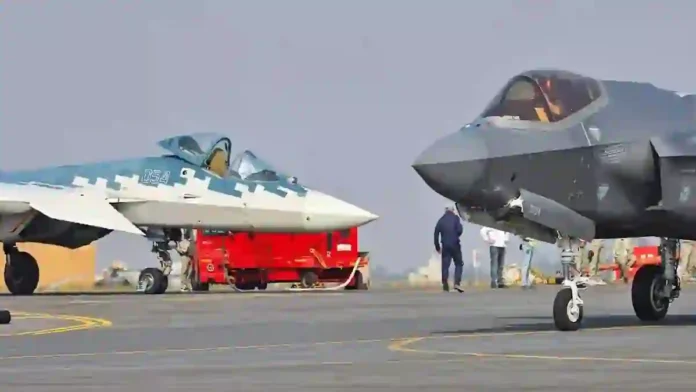The Indian Air Force (IAF) is expected to recommend to the Indian government the acquisition of stealth aircraft as part of its modernisation efforts and driven primarily by India’s security assessments regarding its neighbouring threats, particularly from China. This decision comes in light of increasing regional tensions and a significant shortfall in the IAF’s operational capabilities, currently operating only 31 active squadrons against an approved strength of 42, reports Business Standard news portal.
Key Considerations For Stealth Aircraft Acquisition
Threat Assessment: The IAF’s push for stealth capabilities is driven by a comprehensive threat assessment, particularly concerning China’s expanding military capabilities and its advanced fighter jets like the Chengdu J-20. The IAF aims to bridge a technological gap that could compromise national security. The IAF recognises that modern stealth capabilities can significantly enhance operational effectiveness by evading conventional radar systems and delaying enemy responses during conflicts.
Options Under Evaluation: U.S. F-35: The United States has proposed the sale of Lockheed Martin’s F-35 stealth fighter. However, concerns regarding its high cost (approximately $80 million per unit) and maintenance expenses have been raised.
Russian Su-57: Alternatively, Russia offers to locally produce the Su-57 stealth fighter under India’s “Make in India” initiative, which includes full technology transfer. This option aligns with India’s strategic goals to enhance domestic defence production capabilities.
Indigenous Development: In parallel, India is advancing its own fifth-generation fighter project, the Advanced Medium Combat Aircraft (AMCA), which is expected to be operational by 2034. This aircraft will feature advanced stealth technology and is part of India’s broader strategy for self-reliance in defence manufacturing.
The IAF’s recommendation for stealth aircraft acquisition reflects a dual strategy: enhancing immediate operational capacity through foreign procurement while simultaneously developing indigenous capabilities. This approach aims to ensure that India remains competitive in an increasingly complex geopolitical landscape, particularly with respect to China and Pakistan’s military advancements.
Read- Navy’s ₹60,000 Crore Rafale-M Jet Deal To Help Upgrade Capabilities of IAF Rafales
The comparison between the F-35 and the Sukhoi Su-57 highlights significant differences in capabilities, costs, and operational roles.
F-35
The F-35 is a multi-role stealth fighter designed primarily for penetrating contested airspace and conducting precision strikes. It comes in three variants: conventional take-off and landing (CTOL), short take-off and vertical landing (STOVL), and carrier-based. It has a top speed of Mach 1.6 and a combat range of approximately 1,500 kilometers. The F-35 features advanced stealth technology with a radar cross-section (RCS) of about 0.0015 square meters, making it difficult to detect. It has been tested in various combat scenarios, demonstrating effectiveness in real-world operations.
Su-57
The Su-57 is primarily an air superiority fighter with a focus on agility and dogfighting capabilities. It is equipped with thrust-vectoring engines for enhanced manoeuvrability. The Su-57 boasts a higher top speed of Mach 2 and a combat range of around 1,900 kilometers. Its RCS is estimated to be between 0.1 and 0.5 square meters, which is larger than that of the F-35 but still incorporates stealth features. While the Su-57 has seen limited action, including involvement in Ukraine, it lacks the extensive combat history of the F-35.
Comparison Table
| Feature | F-35 | Su-57 |
|---|---|---|
| Unit Cost | $80 million – $110 million | $30 million – $40 million |
| Operating Cost | $44,000 per flight hour | $24,000 per flight hour |
| Top Speed | Mach 1.6 | Mach 2 |
| Combat Range | ~1,500 km | ~1,900 km |
| Stealth RCS | ~0.0015 square meters | ~0.1 – 0.5 square meters |
| Primary Role | Multi-role stealth attack | Air superiority |
The final decision will likely weigh factors such as cost, technology transfer agreements, and geopolitical alliances, especially in light of India’s historical reliance on Russian military hardware and its growing ties with the United States.
BS News
Agencies




